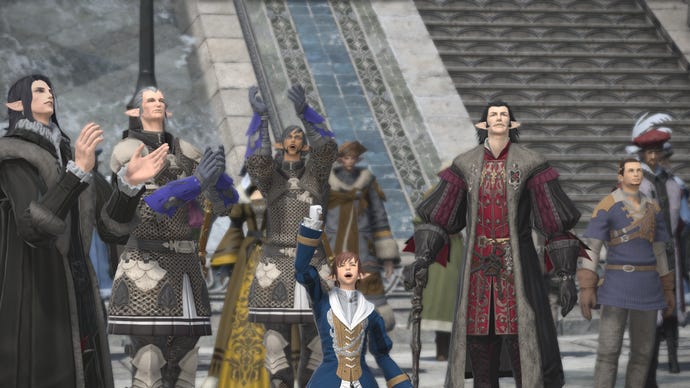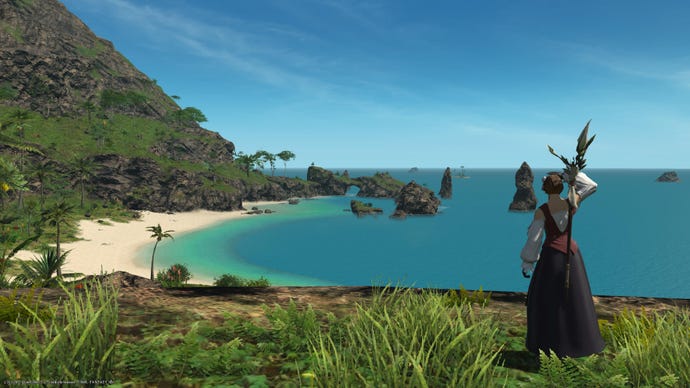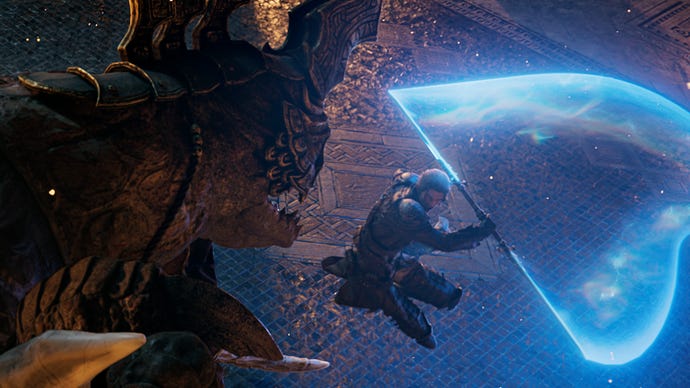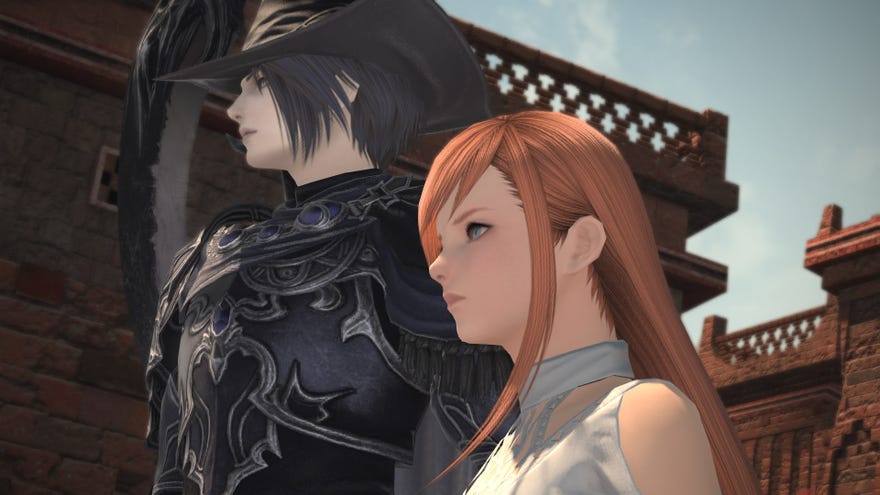Why Final Fantasy XIV failed, and how it recovered
As Final Fantasy XIV Fan Fest departs London, we look at the secret to the MMO's second chance success
Everybody knows some version of the story around Final Fantasy XIV: it came out, it wasn’t very good, it was remade as A Realm Reborn, and now it’s beloved. Over the decade since A Realm Reborn’s release, its reputation has grown with every single expansion. FFXIV’s producer and director Naoki Yoshida (more commonly known as Yoshi P) is now so synonymous with the game that it’s easy to forget he was only brought onto the project in 2010 - after XIV had been released, to overwhelmingly negative reviews.
Square Enix had built a great deal of prestige for the Final Fantasy series in the 2000s. The PlayStation 2 alone saw three mainline Final Fantasy instalments starting with X, and each one was a huge hit with both critics and players. This included Final Fantasy XI: Online, the previous MMORPG to XIV, which released in 2002 and was popular enough to have tie-in novels (that were translated!). If you could define Final Fantasy during this period in one word, it would be “success.” As long as you didn’t pay too much attention to whatever was going on with Advent Children.
Speaking to Noclip in 2017, Yoshi P noted that the franchise’s reputation had led to Square Enix becoming “very arrogant” and “thinking that because they are great, they don’t need to look at other games.” This attitude laid the groundwork for what would become the original version of Final Fantasy XIV, later officially dubbed 1.0. In fact, Final Fantasy XIV was announced at E3 2009 for the PlayStation 3, before XIII had even come out.

One of the main road bumps in FFXIV’s development was the engine it was built on - Square Enix’s internally developed Crystal Tools. Crystal Tools was designed around requests that the studio’s own development teams had, such as “extensive use of character close-ups” and “stylized expressions.” But by trying to make an engine that would satisfy all of Square Enix’s developers, they ended up with something that didn’t really satisfy anyone. So much time was spent on the requests that it was impossible to lock down the final specs of the engine, and so the final specs of FFXIV couldn’t be confirmed either. In one bizarre example, a single flower pot in the game used around 1000 polygons and 150 lines of shader code - roughly the same amount as one of the player characters. XIV 1.0 seemed to reuse areas to cut down on memory usage.
And when XIV 1.0 finally came out in September 2010, it was a complete failure. Review after review criticised every corner of the game’s design, from its environments to its UI to its story, and the prevailing sentiment was: don’t play the game. XIV launched with a free trial period, which was extended twice, but it quickly became obvious that serious changes needed to be made. As Yoshi P told Famitsu in 2012, “this is never going to work unless we put our entire company's resources into this and revamp it.” In essence, XIV 1.0 had been built using so many misplaced priorities that it was fundamentally flawed. The bespoke engine for the MMO couldn’t render more than 40 characters at a time.
During development there had been a sentiment that any issues that arose could be fixed later, despite there being no plan in place for it. As Square Enix’s former president, Yoichi Wada, laid out in the 2011 Square Enix Annual Fiscal Year Report, “the release of mid-class debut titles with an intention to raise quality in future iterations can be seen as our failure.”
In December 2010, Wada publicly announced a few major changes to the state of FFXIV: firstly that Square Enix were committed to fixing the game; secondly, that until a “concrete plan outlining Final Fantasy XIV’s future” had been secured, they would be pausing fees and delaying the PlayStation 3 version; and thirdly, there would be large changes to the development team. XIV’s former producer and director, Hiromichi Tanaka and Nobuaki Komoto, would step down immediately, with Tanaka issuing his own statement taking “full responsibility” for the state of the game. Replacing both roles would be a then-publicly-unknown staff member who had previously directed several Dragon Quest games — Naoki Yoshida.


After assessing the state of the game, Yoshi P put forward a plan to regain the trust of the Final Fantasy audience: secretly begin production of a completely new game to replace XIV, while at the same time continuing to patch XIV 1.0 for the game’s dedicated audience. These patches included huge features like an entire job system, an overhaul of the combat, and a new story. There was a fast-approaching time limit for all of this though, because with every day that passed, people’s interest in FFXIV was fading. One of the internal goals was to release the PS3 version that was promised years ago, as a sign of Square Enix’s commitment to their fans — they spent around 21 months perfecting the UI for both controllers & mouse and keyboard. It was definitely a huge risk, but it was one that could be taken because development was “all funded 100 percent by Square Enix.”
Building a game, especially an MMORPG, takes a lot of time. World Of Warcraft took 4-5 years to develop, and that was almost a decade prior to the launch of A Realm Reborn in 2013. According to Square Enix’s internal schedule, XIV’s team would have to somehow compress this work into 2-3 years. To save time, Yoshi P made around 400 decisions on the base game design of A Realm Reborn, beginning with building out standard features most MMORPGs have. He assigned designers he trusted to carry out these ideas, while frequently checking in.
While a lot was changing internally, the same had to be done on the outside. One of Yoshi P’s first changes was to improve how Square Enix communicated with XIV’s players. Everybody was paying close attention to all of the negative feedback on 1.0, but rarely were any public statements issued saying as much. Yoshi P altered this; he gave several forthcoming interviews about the underwhelming state of the game and how committed the team were to fixing it, both to journalistic publications and to fansites.
Fansites in particular were crucial because FFXIV did not have forums to begin with. Due to a fear of statements possibly being mistranslated, the 1.0 development team used fansites and unofficial forums to gauge the temperature of the game. Community managers would have to create daily reports on how XIV was being perceived, across all regions, because there was no centralised location for this information. As you can imagine, Yoshi P added official forums.

At the heart of A Realm Reborn was a huge amount of respect for the audience that continued to play 1.0. Today, the story that once made up XIV 1.0’s content is now the off-screen lore for A Realm Reborn. Somehow, despite the previous version of XIV having been unplayable for over a decade, there are still characters from 1.0 cropping up in updates for A Realm Reborn. The guy who appeared on the 2010 box art for FFXIV is now a major character in the story, who even has his own merch. This is fantastic — it doesn’t turn off new players, while rewarding those who have an interest in the original game.
In October 2011, a roadmap was announced for the radically new version of XIV called 2.0. Fees were reinstated at the start of 2012, and in July of that year, 2.0 was officially revealed as A Realm Reborn.
In the final months before A Realm Reborn’s launch, a giant red moon called Dalamud appeared in the sky. At first, it was a small speck in the distance, but with every subsequent patch Dalamud got closer and closer, hurtling towards players until finally, it was right in their faces. Inspired by the then-widespread idea of the world ending in 2012 — which to be clear, it didn’t — the XIV team agreed on having an apocalyptic event permanently close the game, and on November 11th 2012, 1.0’s servers were taken offline.

A Realm Reborn released on August 27th 2013 for both PlayStation 3 and Windows to rave reviews. It’s incredible to think the whole game was developed in two years and eight months, in secret, while patching another game. Back then I don’t think anybody saw XIV being so popular that it would have to literally stop selling copies. Twice. This year saw the fifth major Final Fantasy XIV Fan Fest, the European event having taken place in London this weekend.
The key to XIV’s longevity has been in its great communication and prioritisation of what its players want—a lesson that nobody at Square Enix is probably going to forget for a while. You do have to wonder though, with another transformative expansion on the horizon, will Final Fantasy ever need another MMORPG?








